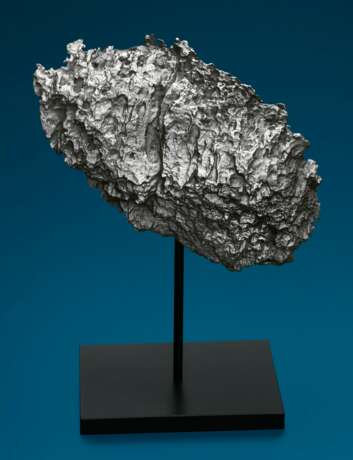ID 389945
Lot 2 | DRONINO METEORITE — EXOTICA FROM OUTER SPACE
Estimate value
$ 3 000 – 5 000
A mesmerizing display of a crenelated surface texture is seen throughout — the result of a centuries-long interaction of the meteorite’s unique composition with Earth’s soil and groundwater. Ellipsoidal in form, the meteorite tapers along its perimeter. With a patina that ranges in hues from pewter to platinum, this abstract, otherworldly conversation piece from the asteroid belt is accompanied by a custom armature.
101 x 153 x 47mm (4 x 6 x 1.75 in.)
1.957kg (4.33 lbs)
Dronino is a highly exotic meteorite; no other meteorite looks like this. The unique crenelated surface texture of this iron meteorite is the result of its unique chemical composition, the alkalinity of the soil into which it fell and the amount of water to which it was exposed for more than 1,000 years. Dronino specimens belong to the exclusive “ungrouped” population of iron meteorites. While 90% of iron meteorites are members of established chemical groups, the other 10% are chemically unrelated to other specimens. Dronino is one of these unusual, ungrouped irons.
They were first discovered in 2000 by a mushroom hunter outside an ancient town founded in 1152. As nothing was ever written about what would have been an exceedingly memorable event of a fireball accompanied by smoke trails and sonic booms, it’s likely that Dronino’s arrival occurred when the area was unpopulated. Given the high degree of terrestrial weathering (which is chiefly responsible for the unusual shapes of Dronino specimens), a descent to Earth more than a millennium ago can be confidently inferred. Hewn by forces both on and off Earth, the result is this exotic extraterrestrial form from outer space.
Christie's would like to thank Dr. Alan E. Rubin at the Institute of Geophysics and Planetary Physics, University of California, Los Angeles for his assistance in preparing this catalogue.
| Address of auction |
CHRISTIE'S 8 King Street, St. James's SW1Y 6QT London United Kingdom | |
|---|---|---|
| Preview |
| |
| Phone | +44 (0)20 7839 9060 | |
| Buyer Premium | see on Website | |
| Conditions of purchase | Conditions of purchase |



